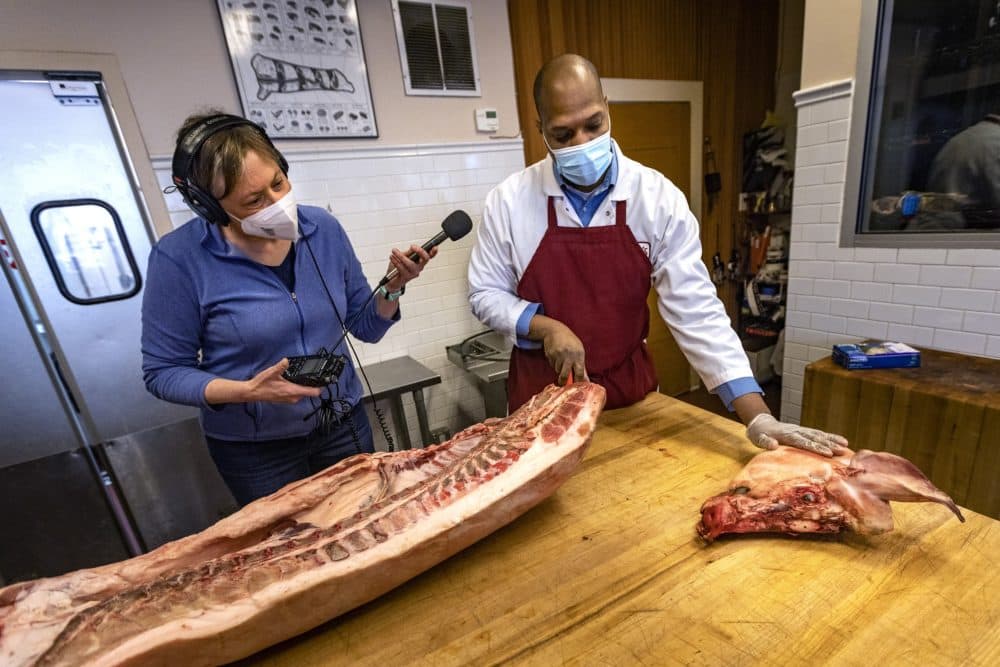Advertisement
Field Guide to Boston
10 ways to eat more sustainably in New England

Climate change is overwhelming, but there’s something we do every day that can change your carbon footprint: we eat.
For my three-week newsletter “Cooked: the search for sustainable eats,” I spent six months talking to anyone who could help me understand how our food choices affect the environment. WBUR even hired some graduate students from Tufts to dig around and crunch some numbers for us. Some of what I learned surprised me, and I bet it will surprise you, too.
If you sign up for Cooked, I’ll show you what you can do in your own kitchen with your own food to help the planet — and have a good time doing it. You can subscribe here. In the meantime, here are the top 10 takeaways that made the biggest impression on me, just to whet your appetite. Enjoy!
1. The simplest thing you can do: Eat less beef.
Cows burp (and fart) a lot of methane, a greenhouse gas about 30 times more potent than carbon dioxide. A 2022 study found that swapping out beef for chicken (or almost anything, really) for one meal a day dropped a person’s daily dietary carbon footprint by 48%.
2. Grass-fed beef has a higher carbon footprint than conventional beef, but it can be better for the planet in other ways.
Grass-fed cattle take longer to reach slaughter weight than conventional cattle, giving them more time to produce methane. However, grass-fed beef requires less additional feed, uses far less water and can provide other ecosystem benefits, like carbon sequestration in the soil. The Tufts students found that individual farm practices, like efforts to reduce water use and implement good manure storage practices, could further lower environmental impacts.
3. Vegan food-substitutes have lower environmental impacts than their real-life counterparts.
Vegan milk, meat, eggs and cheese all beat out the competition when it comes to their foodprints. However, a 2022 study that pitted vegan soy schnitzel against pork schnitzel across 15 environmental impacts, found the vegan version won. Then, the researchers factored in the nutritional value. The vegan schnitzel still won, but not by much.
But you know what? The researchers suggest that unprocessed beans, lentils and chickpeas may be better for the planet and your health than any kind of schnitzel.
4. A lot of the research showing the environmental superiority of vegan food substitutes was funded by companies that make vegan food substitutes.
This doesn’t mean the research is bad, but it does raise the question of bias. There’s a lot more research to be done.
5. If you want to drink fake milk, drink whatever fake milk you want.
The data is imperfect, but it appears that oat and soy milk (and maybe pea milk) consistently have lower environmental impacts than rice and almond milks. Almonds are concerning because they require a lot of water to grow, and the vast majority of almonds grown in the U.S. come from water-hungry California. But the water used for almonds “is still significantly less than the water used for dairy milk,” points out Tufts student Julia Hesse-Fong. Also, almonds grow on trees that store carbon. The bottom line: no matter what vegan milk you choose, it has a lower environmental impact than dairy.
6. Food miles aren’t that big a deal (for most foods).
For cheese, for instance: “Most of the impacts come from the production of milk,” said Tufts student Alexandra Stern. Food miles account for about 11% of a food’s emissions, so the fact that it's local doesn't change its carbon footprint much. One important exception: wild-caught fish. Since we don’t need to feed, water or fertilize wild fish, most of their carbon footprint (finprint?) comes from processing and transport. So, eat local fish when you can!
7. Local isn’t automatically better for the planet.
How a food is produced — and how it gets to your kitchen — can matter more than where it grew. For example, a local greenhouse could use a lot of fossil-fuel energy to heat it through the winter; food shipped by train has a lower environmental impact than food you picked up in your car after driving three hours to a farm.
8. But, local food has lots of other advantages.
Buying local food supports local economies and offers fresher produce with fewer preservatives. Local farms also tend to grow a greater variety of crops that can support ecosystems and genetic diversity.
Growing more food closer to home will also make the region more resilient to supply chain issues or serious weather disruptions due to climate change, said Lisa Fernandes, communication director for Food Solutions New England. “Building up a strong enough, resilient regional food system in New England is something that you'd rather be five years too early than five weeks too late to do.”
9. Food waste is a big problem! But there are lots of easy ways you can help fix it.
America’s wasted food is equivalent to the annual CO2 emissions of 42 coal-fired power plants. About a quarter to a third of wasted food comes from people’s homes. This makes households the largest producers of food waste in the country.
One of the best ways to avoid wasting food is to upcycle your leftovers. SaveTheFood and Food Waste Feast have user-friendly search-by-food websites that show you how to transform your wilted basil and funky apples into pesto and bread pudding, respectively. Edible Boston also has some useful tips on turning anything into a fritter or dumpling.
10. The little things you do matter a lot, especially when you start asking questions.
What you choose to eat influences the people around you, and can also change what restaurants and grocery stores sell. Ask questions about where your food comes from and how it was grown, and the food system will start to change.
Plus, you’ll feel better. Frances Moore Lappé, who wrote "Diet For A Small Planet" 50 years ago, said, “Every choice I make that is aligned with the world I want … I feel less like a victim and I feel more powerful.” And with a problem as big as climate change, that’s a good way to feel.
